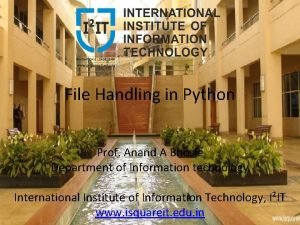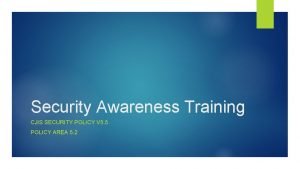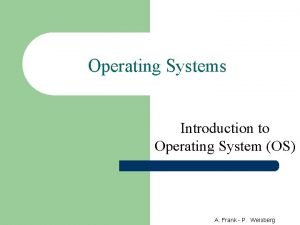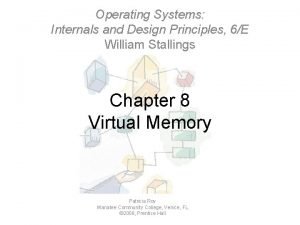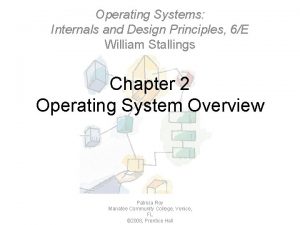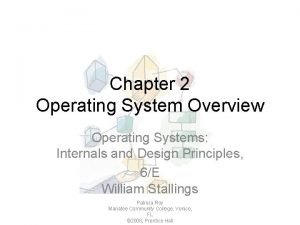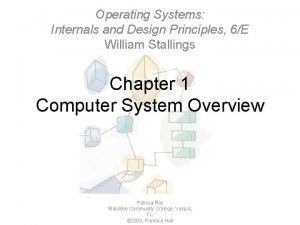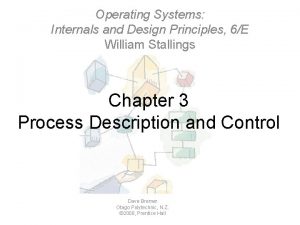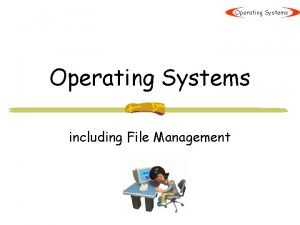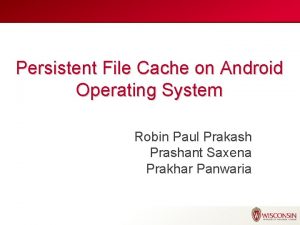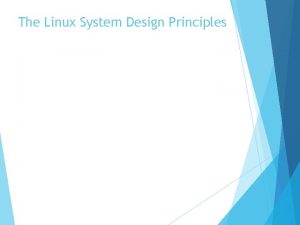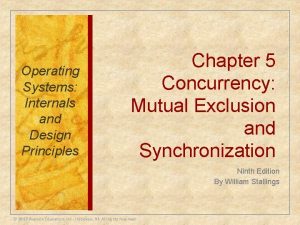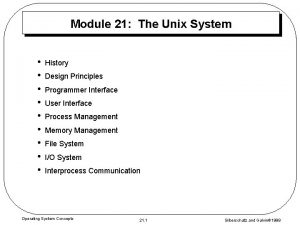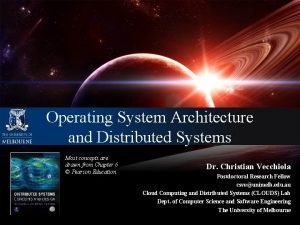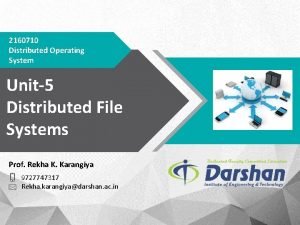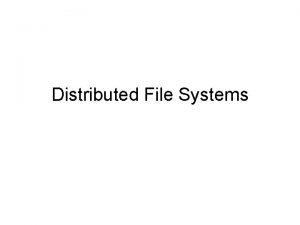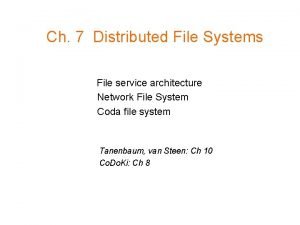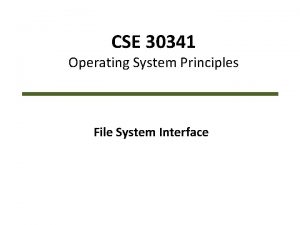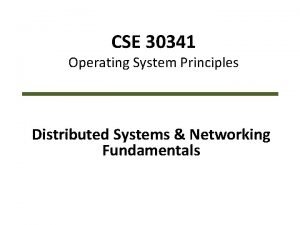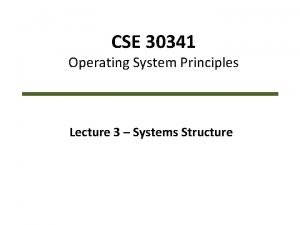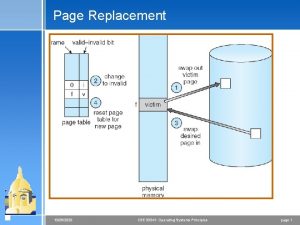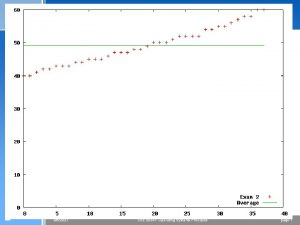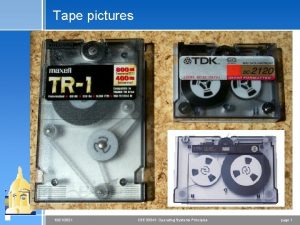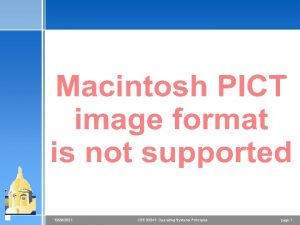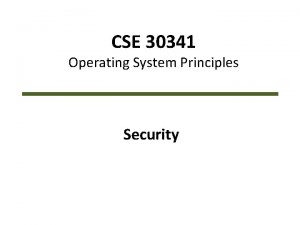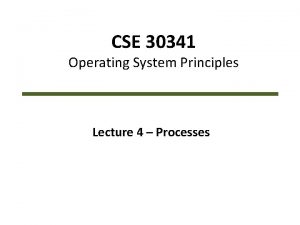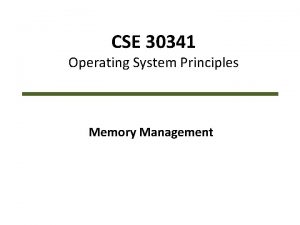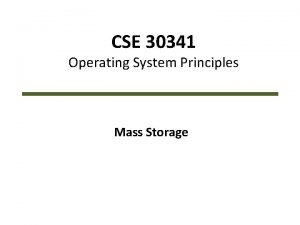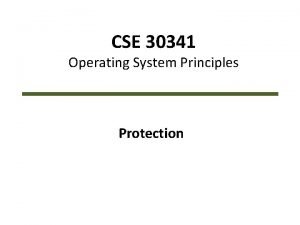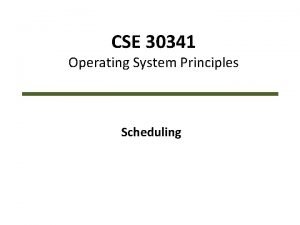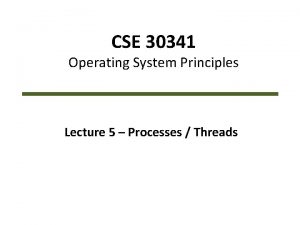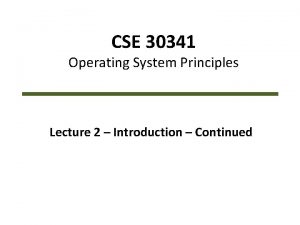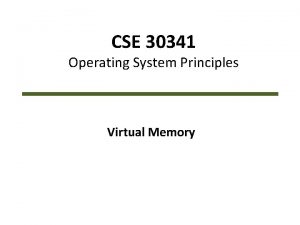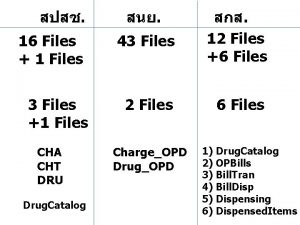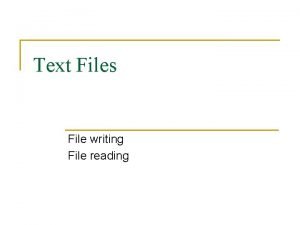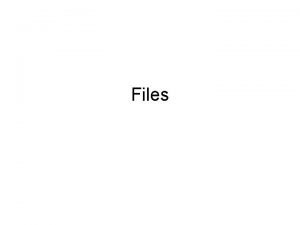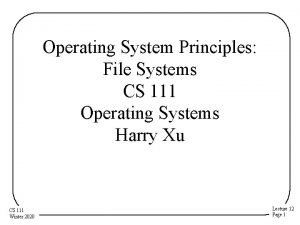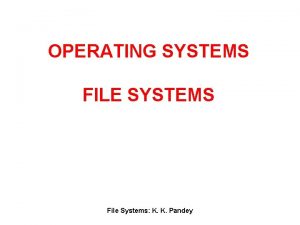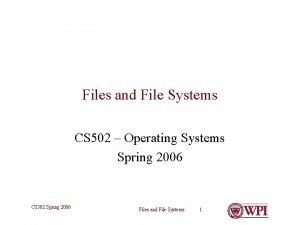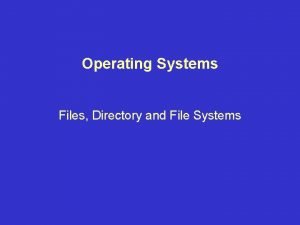CSE 30341 Operating System Principles File Systems Files


































- Slides: 34

CSE 30341 Operating System Principles File Systems

Files & File Systems • • • File Concept Access Methods Directory Structure File-System Mounting File Sharing Protection CSE 30341 – Operating System Principles 2

File Concept • Contiguous logical address space • File = collection of related information recorded on secondary storage • Types: File “interpretation” is up to user/program – Data • Numeric (text, ASCII; “LINE_MAX” bytes) • Character (text, ASCII; “LINE_MAX” bytes) • Binary (executable, readable by computer) – Program CSE 30341 – Operating System Principles 3

File Structure • None - sequence of words, bytes • Simple record structure – Lines – Fixed length – Variable length • Complex Structures – Formatted document • Who decides: – Operating system – Program CSE 30341 – Operating System Principles 4

Example Structures CSV XML <Participant FN=“Christian” LN=“Poellabauer”> <Publication Year=“ 2008” /> <Publication Year=“ 2009” /> </Participant> Poellabauer, Christian, 5, 3. 45 Doe, Jane, 6, 3. 98 Bowyer, Kevin, 4, 4. 25 Structured Poellabauer Christian cpoellab Bualuan Ramzi rbualuan Thain Doug dthain CSE 30341 – Operating System Principles struct Prof. Info { char sz. Last[41]; char sz. First[31]; char sz. Net. ID[11]; }; 5

File Attributes • Name – only information kept in human-readable form • Identifier – unique tag (number) identifies file within file system • Type – needed for systems that support different types • Location – pointer to file location on device • Size – current file size • Protection (ACL) – controls who can do reading, writing, executing • Time, date, and user identification – data for protection, security, and usage monitoring • Information about files are kept in the directory structure, which is maintained on the disk CSE 30341 – Operating System Principles 6

File Operations • File is an abstract data type • Basic operations on files: – – – Create Write Read Reposition within file Delete Truncate • Open(Fi) – search the directory structure on disk for entry Fi, and move the content of entry to memory • Close (Fi) – move the content of entry Fi in memory back to directory structure on disk • Opening files: “remember” used files; efficiency; convenience CSE 30341 – Operating System Principles 7

Open Files • Several pieces of data are needed to manage open files: – File pointer: pointer to last read/write location, per process that has the file open – File-open count: counter of number of times a file is open – to allow removal of data from open-file table when last processes closes it – Disk location of the file: cache of data access information – Access rights: per-process access mode information CSE 30341 – Operating System Principles 8

Open File Locking • Provided by some operating systems and file systems (flock and fcntl system calls) • Mediates access to a file • Mandatory or advisory: – Mandatory – access is denied depending on locks held and requested – Advisory – processes can find status of locks and decide what to do CSE 30341 – Operating System Principles 9

File Types – Name, Extension CSE 30341 – Operating System Principles 10

Access Methods • • Sequential Access Direct Access read next write next reset skip forward read n write n position to n read next write next rewrite n n = relative block number CSE 30341 – Operating System Principles 11

Sequential-Access File CSE 30341 – Operating System Principles 12

Simulation of Sequential Access on Direct-Access File CSE 30341 – Operating System Principles 13

Directory Structure • A collection of nodes containing information about all files Directory Files F 1 F 2 F 3 F 4 Fn Both the directory structure and the files reside on disk Backups of these two structures are kept on tapes CSE 30341 – Operating System Principles 14

Disk Structure • Disk can be subdivided into partitions • Disks or partitions can be RAID protected against failure • Disk or partition can be used raw – without a file system, or formatted with a file system • Partitions also known as minidisks, slices • Entity containing file system known as a volume • Each volume containing file system also tracks that file system’s info in device directory or volume table of contents • In addition to general-purpose file systems, there can be many special-purpose file systems CSE 30341 – Operating System Principles 15

A Typical File-system Organization CSE 30341 – Operating System Principles 16

Operations Performed on Directory • Search for a file • Create a file • Delete a file • List a directory • Rename a file • Traverse the file system CSE 30341 – Operating System Principles 17

Organize the Directory (Logically) to Obtain • Efficiency – locating a file quickly • Naming – convenient to users – Two users can have same name for different files – The same file can have several different names • Grouping – logical grouping of files by properties CSE 30341 – Operating System Principles 18

Single-Level Directory • A single directory for all users Naming problem Grouping problem CSE 30341 – Operating System Principles 19

Two-Level Directory • Separate directory for each user n Path name n Can have the same file name for different user n Efficient searching n No grouping capability CSE 30341 – Operating System Principles 20

Tree-Structured Directories CSE 30341 – Operating System Principles 21

Tree-Structured Directories (Cont. ) • Efficient searching • Grouping Capability • Current directory (“working directory”) – cd /spell/mail/prog – cd ~ – cd. . CSE 30341 – Operating System Principles 22

Tree-Structured Directories (Cont) • Absolute or relative path name • Creating a new file is done in current directory • Delete a file rm <file-name> • Creating a new subdirectory is done in current directory mkdir <dir-name> Example: if in current directory /mail mkdir count Deleting “mail” deleting the entire subtree rooted by “mail” CSE 30341 – Operating System Principles 23

Acyclic-Graph Directories Symbolic links in UNIX CSE 30341 – Operating System Principles 24

Acyclic-Graph Directories CSE 30341 – Operating System Principles 25

General Graph Directory (Cont. ) • How do we guarantee no cycles? – Allow only links to files, not subdirectories – Every time a new link is added use a cycle detection algorithm to determine whether it is OK – Ignore links for activities such as recursive search/delete/etc. CSE 30341 – Operating System Principles 26

File System Mounting • A file system must be mounted before it can be accessed • A unmounted file system is mounted at a mount point CSE 30341 – Operating System Principles 27

(a) Existing (b) Unmounted Partition CSE 30341 – Operating System Principles 28

Mount Point CSE 30341 – Operating System Principles 29

File Sharing • Sharing of files on multi-user systems is desirable • Sharing may be done through a protection scheme • On distributed systems, files may be shared across a network • Network File System (NFS) is a common distributed file-sharing method CSE 30341 – Operating System Principles 30

File Sharing – Multiple Users • User IDs identify users, allowing permissions and protections to be per-user • Group IDs allow users to be in groups, permitting group access rights CSE 30341 – Operating System Principles 31

Protection • File owner/creator should be able to control: – what can be done – by whom • Types of access – Read – Write – Execute – Append – Delete – List CSE 30341 – Operating System Principles 32

Access Lists and Groups • Mode of access: read, write, execute • Three classes of users a) owner access 7 b) group access 6 c) public access 1 RWX CSE 30341 – Operating System Principles 111 110 001 33

A Sample UNIX Directory Listing CSE 30341 – Operating System Principles 34
 Dot powai files are binary files
Dot powai files are binary files Cjis training
Cjis training Ncic hosts restricted files and non-restricted files
Ncic hosts restricted files and non-restricted files File-file yang dibuat oleh user pada jenis file di linux
File-file yang dibuat oleh user pada jenis file di linux File system in operating system
File system in operating system File system in operating system
File system in operating system File system in operating system
File system in operating system Module 4 operating systems and file management
Module 4 operating systems and file management Operating system internals and design principles
Operating system internals and design principles Operating systems: internals and design principles
Operating systems: internals and design principles Operating systems: internals and design principles
Operating systems: internals and design principles Operating systems: internals and design principles
Operating systems: internals and design principles Operating systems: internals and design principles
Operating systems: internals and design principles Operating systems internals and design principles
Operating systems internals and design principles Operating system internals and design principles
Operating system internals and design principles File management operating system
File management operating system File management in android operating system
File management in android operating system Components of operating system
Components of operating system Distributed file system
Distributed file system In a file-oriented information system, a transaction file
In a file-oriented information system, a transaction file Dicapine
Dicapine System design principles
System design principles Operating system internals and design principles
Operating system internals and design principles Unix design principles
Unix design principles Architecture of distributed operating system
Architecture of distributed operating system Allows the replication of only immutable
Allows the replication of only immutable Physical image vs logical image
Physical image vs logical image File sharing management system
File sharing management system An html file is a text file containing small markup tags
An html file is a text file containing small markup tags Cse 340 principles of programming languages
Cse 340 principles of programming languages Cse 340 principles of programming languages
Cse 340 principles of programming languages Buddy system operating system
Buddy system operating system File system modules in distributed system
File system modules in distributed system Explain file service architecture
Explain file service architecture Some example of operating system
Some example of operating system
